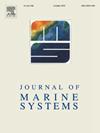Impact of coral bleaching on symbiotic microbial communities and carbon fixation pathways in the South China Sea
IF 2.5
3区 地球科学
Q2 GEOSCIENCES, MULTIDISCIPLINARY
引用次数: 0
Abstract
Microorganisms play a crucial role in supplying essential nutrients to corals, thereby enhancing their survival under environmental stress. However, the diversity and ecological functions of carbon-fixing microorganisms in coral symbiosis remain poorly understood. In this study, we employed metagenomic analysis to investigate microbial responses to coral bleaching and their impact on carbon fixation pathways in the South China Sea. Principal coordinates Analysis (PCoA) revealed that both bleaching and coral species significantly influenced the symbiotic microbial community composition. Bleached corals exhibited a substantial increase in heterotrophic microorganisms. The findings demonstrated the presence of complete photosynthetic and prokaryotic carbon fixation pathways within coral holobionts, with a clear shift in microbial carbon metabolism following bleaching. Function analysis shows a decrease in key enzymes of photosynthetic carbon fixation and an increase in prokaryotic carbon fixation enzymes in bleached corals, indicating the activation of the prokaryotic carbon fixation pathway in bleached corals. In addition to Symbiodiniaceae, other microbial taxa contributed to carbon fixation, with Suessiales, Cladophorales, Oscillatoriales, Rhodospirillales, and Rhodobacterales identified as the major contributors. Notably, Cladophorales (Boodlea and Botryococcus) emerged as key contributors to RuBP carboxylase activity in bleached corals. These results highlight the significant role of microbial carbon fixation within coral holobionts and provide a foundation for future research on lineage-specific carbon-fixing microorganisms.
珊瑚白化对南海共生微生物群落和固碳途径的影响
微生物在为珊瑚提供必需的营养物质,从而提高珊瑚在环境压力下的存活率方面起着至关重要的作用。然而,对珊瑚共生中固定碳微生物的多样性和生态功能仍知之甚少。在这项研究中,我们采用宏基因组分析研究了南海微生物对珊瑚白化的反应及其对碳固定途径的影响。主坐标分析(PCoA)表明,白化和珊瑚种类对共生微生物群落组成均有显著影响。白化的珊瑚显示出异养微生物的大量增加。研究结果表明,珊瑚全息生物中存在完整的光合作用和原核碳固定途径,漂白后微生物碳代谢发生明显变化。功能分析表明,漂白珊瑚光合固碳关键酶减少,原核固碳酶增加,说明漂白珊瑚激活了原核固碳途径。除共生菌科外,其他微生物类群也对固定碳有贡献,其中Suessiales、Cladophorales、Oscillatoriales、Rhodospirillales和Rhodobacterales是主要的固定碳类群。值得注意的是,Cladophorales (Boodlea和Botryococcus)成为漂白珊瑚中RuBP羧化酶活性的关键贡献者。这些结果突出了微生物固碳在珊瑚全息生物中的重要作用,并为未来研究特定谱系的固碳微生物提供了基础。
本文章由计算机程序翻译,如有差异,请以英文原文为准。
求助全文
约1分钟内获得全文
求助全文
来源期刊

Journal of Marine Systems
地学-地球科学综合
CiteScore
6.20
自引率
3.60%
发文量
81
审稿时长
6 months
期刊介绍:
The Journal of Marine Systems provides a medium for interdisciplinary exchange between physical, chemical and biological oceanographers and marine geologists. The journal welcomes original research papers and review articles. Preference will be given to interdisciplinary approaches to marine systems.
 求助内容:
求助内容: 应助结果提醒方式:
应助结果提醒方式:


